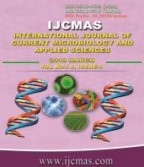


 National Academy of Agricultural Sciences (NAAS)
National Academy of Agricultural Sciences (NAAS)

|
PRINT ISSN : 2319-7692
Online ISSN : 2319-7706 Issues : 12 per year Publisher : Excellent Publishers Email : editorijcmas@gmail.com / submit@ijcmas.com Editor-in-chief: Dr.M.Prakash Index Copernicus ICV 2018: 95.39 NAAS RATING 2020: 5.38 |
One of the photosynthetic bacterial isolate L6 grown at 10 oC confirmed as Rhodoferax sp. and six isolates showed growth at 30 °C were isolated from municipal wastes in Kashmir and Ladakh valleys. The cells were Gram-negative, pigmented, non-spore-forming, mostly oxidase positive except K2 isolate and nitrate reduction negative except G17 isolate. All isolates showed growth in aerobic-light conditions except K2 and anaerobic-light except L6. All isolates utilized acetate, malate and succinate as carbon source while as benzoate and mannitol were not used except G17. However mannitol was used as carbon source by L6 also. Isolate K2 had shown well defined growth in sulphide medium and was regarded as sulphur bacterium while as isolates G17, L6, L27, K5, S5 and S7 were unable to utilize sulphide and thiosulphate as electron donor and considered as non sulphur bacteria. The morpho-biochemical test further confirmed K2 isolate as Chlorobium sp., S5 and L27 as Rhodospirillum sp., S7 as Rhodobacter sp., G17 as Rhodopseudomonas sp., K5 as Rhodomicrobium sp. Isolates G17, L6, L27, S5 and S7 were observed the most efficient on the basis of versatility in carbon utilization character. Isolate L6 was regarded as the psychrophillic/psychrotolerant photosynthetic purple non sulphur bacterium.
 |
 |
 |
 |
 |